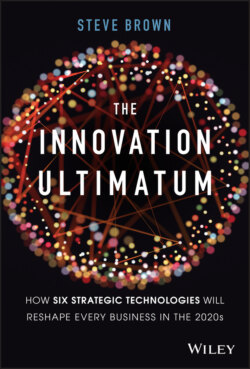Читать книгу The Innovation Ultimatum - Steve Brown - Страница 42
Example: A Radiology AI
ОглавлениеTo train a neural network to read radiology charts and look for tumors, you would expose it to many example charts (the input), each tagged with a radiologist's diagnosis—tumor or no tumor (the desired output). The output of the network is a single number, the probability that an image contains a tumor. Each time the neural net is exposed to a new image, the output of the network is compared with the correct result. If an image of a tumor is presented, the result should be close to 100%. If there's no tumor the result should be close to zero. The backprop process is used to tweak the network's model (the weightings of the connections between the nodes), strengthening the weightings of links that lead to the correct result, and weakening those that don't. Once trained with enough data, the neural network will predict the right diagnosis with impressive accuracy. A more complex network might have several outputs. One could be the percentage chance of a tumor, another the probability of an embolism, another the probability of a broken bone, and so on.
If this all seems too difficult to understand, that's okay. The key thing to understand is that neural nets can infer how to perform tasks from examples, without the need of a domain expert to supply explicit rules on how to perform that task.
Radiologists train for many years to read x-rays, computer tomography (CT), magnetic resonance imaging (MRI), and positron emission tomography (PET) images. After medical school, radiologists do additional training, often involving a four-year residency. Some do additional specialization training after that. Reading images to look for tumors and other ailments uses all of the radiologist's skill, experience, and training. Yet this task is within the reach of a neural network. Given enough training data, an AI can be built with diagnostic abilities similar to those of a human radiologist, a person with about a decade of intense education behind them. As we train the neural network, we are essentially codifying the collective knowledge, and several decades of professional experience, from hundreds of thousands of radiologists. Their experience and diagnostic insight are captured in the model that's generated.
Some radiologists already use AI-based tools to offer a “second opinion” as they read charts. As the accuracy of these tools surpasses that of human radiologists on routine charts, radiologists will be able to focus their attention on more complex, higher-value, and more patient-centered tasks and procedures. The progress made in radiology portends the future for other branches of medicine. Machine learning will be applied to many other fields of medical diagnosis and pathology in the coming decade.
While training an AI requires serious amounts of computing performance to create a model, using that model requires significantly less performance. The process of using a model is known as inference. Often, training occurs on workstations or in the cloud, while inference occurs on devices. Most future computer chips will include inference engines, silicon accelerators optimized to run AI models with relative ease.
